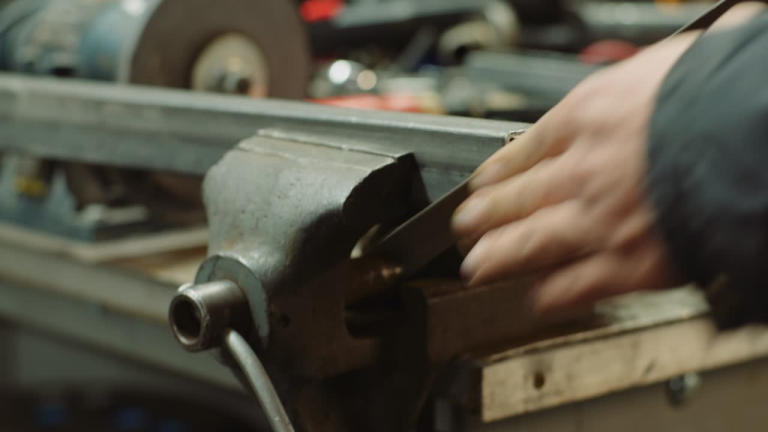Do you have a metal object that you need to sand down? Whether it’s a piece of furniture, a tool, or something else entirely, this comprehensive guide will show you how to do it. We’ll walk you through the entire process, from selecting the right Sandpaper to avoiding common mistakes. So whether you’re a beginner or an experienced DIYer, this guide has covered!
What is sanding?
Sanding is removing small pieces of material from a workpiece by abrasion with Sandpaper. Sanding can remove rust, paint, or other finishes from metal surfaces.
Why was it essential to sand down the Metal?
The main reason to sand down Metal is to remove rust. Rust can weaken the Metal, making it more susceptible to breakage. It can also cause the Metal to discolor or pit. Sanding down the Metal will remove any rust and provide a smooth surface for painting or other finishes.
Another reason to sand down Metal is to prepare it for welding. Metal that has not been sanded down can have a rough surface that can cause the weld to be less intense. Sanding down the Metal will create a smooth surface that will allow for a stronger weld.
It is always best to sand down Metal before painting or welding. It will ensure that you have a smooth surface to work with and that the paint or weld will adhere properly. Sanding down a metal can be a time-consuming task, but it is well worth the effort to get a professional-looking finish.

What are the different types of Sandpaper?
There are many types of Sandpaper, each with its advantages and disadvantages. The most common type is probably aluminum oxide, suitable for general-purpose sanding. For more challenging projects, you might want to use silicon carbide paper. It is a more complicated type of Sandpaper that can grind down Metal quickly.
If you’re working on a particularly delicate project, you might want to use a softer type of Sandpaper, like garnet paper. It will prevent you from damaging the metal surface.
No matter what type of Sandpaper you use, keep it moving while you’re sanding. If you stay in one spot for too long, you’ll have a divot in the Metal. So keep moving, and keep the pressure even to get the best results.
What is the best Sandpaper to sand down Metal?
There are a few different types of Sandpaper that can be used to sand down Metal, but the best type to use is garnet paper. Garnet paper is a natural abrasive that will not clog up as quickly as other types of Sandpaper, making it ideal for sanding down Metal.
Materials needed to sand down Metal?
To sand down Metal, you will need the following materials: Sandpaper, a metal file, and a polishing compound. You will also need access to a power drill or a hand-held sander.

- 50 pieces of 9" x 11" D-weight latex backed sandpaper sheets
- Garnet grain for general purpose sanding on wood
- Provides a fine, smooth finish on wood
- Sheets can be cut to fit hand sanding on a sanding block or a power tool sander
- Available in grits 36 - 240 for all your sanding needs

- Assorted Grits
- Made with garnet abrasive minerals
- Sharp, clean cutting power
- Designed to produce quality smooth finishes

The process to sand down the Metal?
The first step is to gather your materials. You will need a sanding block, coarse-grit Sandpaper, and fine-grit Sandpaper. If you do not have a sanding block, you can use a piece of wood or something similar.
Next, you will need to find a flat surface to work on. A table or countertop will work fine. Make sure that the surface is clean before you begin sanding.
Now, you can begin sanding down the Metal. Start with the coarse-grit Sandpaper and work your way up to the fine-grit paper. Sand in long, even strokes until the entire surface is smooth.
Once you are finished sanding, you will need to clean off the Metal to remove any dust or debris. You can do this with a damp cloth or a vacuum cleaner with a soft brush attachment.
And that’s it! You have now successfully sanded down Metal. Can use this process on any type of metal surface, so feel free to experiment.
How do you sand down the Metal with garnet paper?
To sand down the Metal with garnet paper, you must attach the paper to a sanding block. Start by linking the paper to the sanding block using adhesive tape. Then, wet the metal surface you will be sanding and begin sanding back-and-forth. Be sure to sand with the grain of the Metal to avoid scratches.
After you have finished sanding, remove the garnet paper from the sanding block and dispose of it. Then, wipe down the metal surface with a clean cloth to remove any dust or debris.
How to sand down the Metal using a drill?
If you’re using a drill, start attaching the sanding pad to the drill. Then, set the speed of the drill to low and hold it about an inch away from the metal surface. Begin moving the drill back and forth over the area you want to sand.
As you sand, keep moving the drill around, so you don’t create any deep scratches. After a minute or two, check your progress and sand for longer if necessary. Once you’re happy with the results, remove the sanding pad and clean up any metal filings.
Things to remember before sanding down the Metal?
Before you sand down the Metal, there are a few things you need to remember. First, always wear gloves and a dust mask to protect yourself from the metal particles. Second, make sure the area you’re working in is well ventilated, so you don’t inhale any fumes. Finally, clean up the area afterward, so you don’t leave any metal dust behind.
So, there you have it. We’ve shown you how to sand down Metal like a pro. If you follow these simple steps and take your time, you should be able to get great results. Remember always to use the correct type of Sandpaper for the job, and if in doubt, ask an expert at your local hardware store for help. Have fun with this new skill – and happy sanding!






